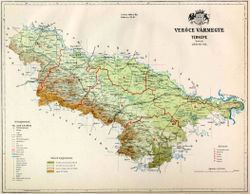12th century–1920 → 1910 4,867 km (1,879 sq mi) | Established 12th century 1910 272,430 | |
 | ||
Virovitica County (Croatian: Virovitička županija; Hungarian: Verőce vármegye) was a historic administrative subdivision (županija) of the Kingdom of Croatia-Slavonia. Croatia-Slavonia was an autonomous kingdom within the Lands of the Crown of Saint Stephen (Transleithania), the Hungarian part of the dual Austro-Hungarian Empire. Its territory is now in eastern Croatia. The name of the county comes from the town of Virovitica. The capital of the county moved from Virovitica to Osijek (Croatian, in Hungarian: Eszék) in the late 18th century.
Contents
Geography
Virovitica County shared borders with the Hungarian counties of Somogy, Baranya, Bács-Bodrog, and the Croatian-Slavonian counties of Srijem, Požega and Bjelovar-Križevci. The county stretched along the right (southern) bank of the river Drava, down to its confluence with the river Danube. Its area was 4867 km² around 1910.
History
The territory of Virovitica County was part of the Kingdom of Croatia when it entered into personal union with the Kingdom of Hungary in 1102, and with it became part of the Habsburg Monarchy in 1526. It was conquered by Ottoman Empire between 1541 and 1552. Ottoman rule in it lasted till 1687. The County was re-established in 1718, after it was retaken from Ottoman rule. In 1920, by the Treaty of Trianon the county became part of the newly formed Kingdom of Serbs, Croats and Slovenes (later renamed to Yugoslavia). Since 1991, when Croatia became independent from Yugoslavia, the county is part of Croatia.
Demographics
In 1900, the county had a population of 243,101 people and was composed of the following linguistic communities:
Total:
According to the census of 1900, the county was composed of the following religious communities:
Total:
In 1910, the county had a population of 272,430 people and was composed of the following linguistic communities:
Total:
According to the census of 1910, the county was composed of the following religious communities:
Total:
Subdivisions
In the early 20th century, the subdivisions of Verőce county were:
